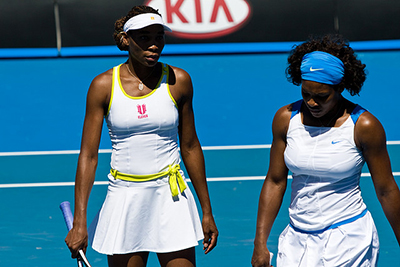 The Williams sisters
Those involved in studying sport actively discuss what they consider to be key factors involved in athletic development. Research over the past few decades has focused on the physiological, psychological, biomechanical and sociological factors that contribute to sporting success, but what role does the family play?
The Williams sisters
Those involved in studying sport actively discuss what they consider to be key factors involved in athletic development. Research over the past few decades has focused on the physiological, psychological, biomechanical and sociological factors that contribute to sporting success, but what role does the family play?
Family influences give rise to a range of interesting discussions with family related topics such as genetics, environmental influences and social issues all identified as being important contributors to athletic development. Research shows that families play an important role in introducing and supporting athletes throughout the various stages of their career, but the question that has rarely been asked is - how does the structure of the family influence sports participation?
In this article I will be exploring the role of the sibling within the family unit - a relatively unexplored area of sports research. Firstly I will look at the birth order of siblings, and in particular the effect of being a later born child.
Are later born children instilled with a competitive streak?
As a younger sibling myself I strived to be as good at sport as my older brother, who excelled at football from a young age. On my first PE lesson I vividly remember my PE teacher saying to me ‘Well let’s see if you are as good as your brother then!’ This only served to fuel my competitive streak and I worked hard to compete with my brother’s success and gain the praise of my parents and teachers. In a newspaper interview Rebecca Adlington’s mother attributed Rebecca’s sporting success to:
‘a matter of the little sister being determined not to be outdone by her big sisters … Because of that early rivalry, she has always had a competitive streak.’
It appears that trying to win favour with parents or getting noticed/recognised is a motivating factor in these gold medal winning athletes. Victoria Pendleton admits to being competitive with her twin brother Alex as a child in order to win favour with her father. Victoria Pendleton comments:
‘I was competitive about absolutely everything with my twin brother and older sister.’
These two athletes are by no means unique. For example, Matthew Pinsent claims his early physical development may have been partly due to a desire to keep up with his two older sisters and it seems that many top performers like Usain Bolt, Laura Trott, Andre Agassi, David Beckham, Chris Hoy and Andy Murray all grew up with older siblings within the family unit.
So is it just a coincidence that these top sports stars are later born children or is there more to it?
What does the research say?
One study found that elite athletes were more likely to be later born children showing an association between birth order and skill level. In an earlier study on the physical performance of pre-school children, those children with older brothers or sisters performed better than only or first born children.
So why is this the case? The competiveness for attention demonstrated by Rebecca Adlington and Victoria Pendleton may be one answer. Evidence suggests that later born children are more competitive (or ego-orientated) than their elder siblings. This is thought to stem from parental tendencies to compare younger siblings to their older counterparts. The eldest sibling’s development is often self-referenced whereas later born children are typically compared to their elder sibling’s stages of development.
This suggests first born children are motivated to learn with younger siblings motivated to win. This provides a potential explanation for studies showing the majority of elite athletes being later born children; however, role modelling may provide another. Many younger siblings who play sport do so because they aspire to be like their older brother or sister. Personality characteristics may also play a part with first born athletes reporting significantly higher cognitive and somatic anxiety compared to later born athletes. For example, athletes with higher anxiety levels are often reported as being less able to cope with the demanding pressures of elite sports performance.
In contrast to these studies, an investigation of Swedish national skiers found that 94% had one or more siblings. However, it did not appear to matter where the skiers were in terms of the birth order of siblings. The distribution among oldest, in the middle, or youngest, was relatively equal. However in one of the larger, multidisciplinary skiing events it appeared that being a younger brother or sister may be an advantage with the majority being younger siblings. So this poses another question - does the type of activity influence the effect birth order has on performance?
What next?
The studies presented here form just the tip of the iceberg with research in this area still in its infancy. However, what is apparent is that sibling rivalry does seem to have some part to play in athletic development, although the exact nature of this is yet to be fully investigated.
In the next Olympic games, it will be interesting to see how our later born siblings fare in the medal tables and may be a good indication of the potential benefits of being a later born child to gain sporting success.
Rate and Review
Rate this article
Review this article
Log into OpenLearn to leave reviews and join in the conversation.
Article reviews